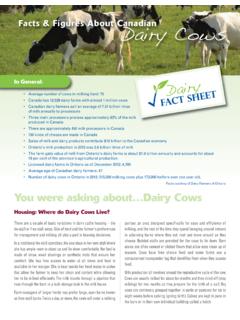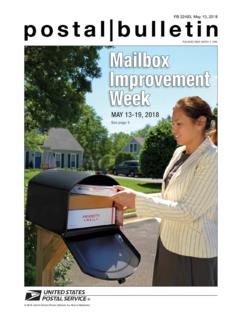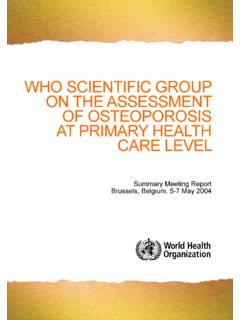Transcription of Thresholds - North American Millers' Association
1 Thresholds Steve L. Taylor, Food Allergy Research & Resource Program University of Nebraska Historical Approach to Dose/Response Physicians recommended completed avoidance (ZERO threshold) Ingestion of small amounts (not well defined) could elicit allergic reactions DBPCFC was the gold standard for diagnosis but challenges often started at 400 500 mg 20%+ of patients reacted to first challenge dose some severe rxns 2013 Entrenched Zero Threshold Concept Physicians recommended complete avoidance Food-allergic consumers attempt to practice complete avoidance Labeling laws and regulations in many countries ( FALCPA in USA)
2 Based on zero threshold (no protein) approach Food industry adopts zero threshold in many situations and advisory labeling abounds 2013 Benefits of Zero Threshold Approach FDA and other public health authorities have easy decisions presence or absence with no debates about amount Food-allergic consumers are protected Physicians can give same advice to all patients with diagnosis of food allergy complete avoidance Food industry has limited flexibility with labeling so less likelihood of errors of enthusiasm 2013 Disadvantages of Zero Threshold Approach Food-allergic consumers have diminished quality of life due to limited food choices FDA
3 And other public health authorities spend time chasing zero Physicians deal with scared and frustrated patients if you treat all of them the same, then they will all believe that they are the most sensitive Food industry focuses attention on zero and applies precautionary labeling (may contain) on widespread basis Zero keeps getting less 2013 BIG Questions Do we now have enough information to move away from the zero threshold concept? If so, what will be the impacts/implications for all of those affected (consumers, physicians, public health authorities, food industry, test kit companies) What are the impediments to implementation of some finite threshold concept?
4 2013 FDA Notice Dec. 2012 7 Key Questions How should we define an allergic response that poses a risk to human health ? Which major food allergens are of greatest public health concern and what is the size of the at-risk population? How should clinical dose distribution data be used in establishing regulatory Thresholds for the major food allergens? 2013 FDA Notice Dec. 2012 7 Key Questions How should clinical dose distribution data be used in establishing regulatory Thresholds for the major food allergens? What data and information exist on dietary exposure patterns for individuals on allergen avoidance diets?
5 What data and information exist on current levels of exposure associated with consumption of undeclared major food allergens in packaged foods? What other information or data should we consider in establishing regulatory Thresholds for major food allergens? 2013 FDA Notice Dec. 2012 7 Key Questions How should we define an allergic response that poses a risk to human health ? Which major food allergens are of greatest public health concern and what is the size of the at-risk population? How should clinical dose distribution data be used in establishing regulatory Thresholds for the major food allergens? 2013 Implications for the Grain Milling Industry Commodity grains standards have existed for decades Labeling of commodity grain contamination is not required under FALCPA (Congressional exemption) Soy in corn; soy in wheat; wheat in oats; etc.
6 With zero threshold concept, pressure would exist to eliminate commodity contamination or label Consumer complaints do not exist but consumers and physicians are unaware of these residues 2013 Regulatory Implications - Comingling Irish Food Safety Authority (IFSA) has detected undeclared soy in corn and wheat products in Irish market during 2011 and 2012 IFSA has petitioned EFSA to require labeling of commodity contamination (decision expected 2014) Canadian Food Safety Authority detected soy in wheat in numerous products during 2012 Health Canada advisory that soy in wheat is not hazardous based on known threshold information FDA Threshold Notice (Dec 2012) 2013 Status of Dose/Response Knowledge circa 2005 Trace amounts (low mg) can elicit allergic reactions A few clinics started doing very low dose DBPCFC and proved that safe doses exist for every subject and that severe reactions did not occur at very low doses (low mg)
7 2013 Consumers and Thresholds Current Situation Many food-allergic consumers believe that they are extremely sensitive Many consumers have experienced allergic reactions due to avoidance diet mistakes Some of those reactions have been quite severe Some consumers believe that they have suffered severe reactions due to low-dose exposures 2013 Public Health Authorities and Thresholds Current Situation Widespread belief that low doses can provoke severe reactions Firm belief that zero threshold protects food-allergic consumers Fear of setting the wrong threshold outweighs empathy about quality of life situation for food-allergic consumers Use of uncertainty factors (100-fold or more) 2013 Current Situation Public health authorities have not established regulatory Thresholds for any of the allergenic foods except Japan (<10 ppm) and Switzerland (<1000 ppm) FALCPA de facto zero threshold for source labeling of ingredients (similar laws in other countries)
8 Industry acutely aware of allergens, no guidance on Thresholds so rampant use of precautionary labeling 2013 2013 Current Situation Quality of life for food-allergic consumers suffers partially as a result of difficulties in adherence to avoidance diets Food-allergic consumers increasingly ignore products with precautionary labels Some physicians advise food-allergic patients to ignore precautionary labels Allergic reactions continue to occur but rarely with packaged foods 2013 US FDA Allergen Thresholds Threshold Working Group Report Approaches to Establish Thresholds for Major Food Allergens and for Gluten in Food (March, 2006)
9 (Journal of Food Protection, Vol. 71, No. 5, 2008, Pages 1043 1088) 2013 Current Focus The FDA Threshold Working Group Report of 2006 favored use of the quantitative risk assessment-based approach QRA based on knowledge of individual threshold doses within the overall population of individuals with a particular food allergy and then uses statistical dose distribution modeling Very data intensive!! 2013 FDA Conclusion Conclusion Finding 4 the quantitative risk assessment-based approach provides the strongest, most transparent scientific analyses to establish Thresholds for the major food allergens. However.
10 The currently available data are not sufficient to meet the requirements of this approach. A research program should be initiated to develop applicable risk assessment tools and to acquire and evaluate the clinical and epidemiological data needed to support the .. approach. Do we have or can we create enough data to use this approach? 2013 The FARRP Approach Sought out published information on individual threshold doses from low-dose clinical challenges Sought out unpublished data from various allergy clinics in multiple countries Established partnership with our primary competitors, TNO in the Netherlands (Geert Houben and colleagues)




